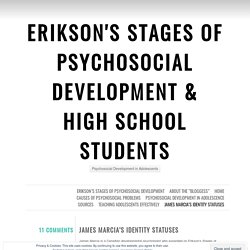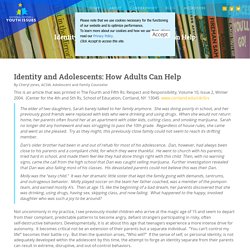

What is adolescence? What do you mean by 'forge a sense of identity'? Introduction. Who is Erik Erikson? Why do teenagers strive to forge a sense of identity? Erikson's Stages of Psychosocial Development. Erik Erikson was an ego psychologist who developed one of the most popular and influential theories of development. While his theory was impacted by psychoanalyst Sigmund Freud's work, Erikson's theory centered on psychosocial development rather than psychosexual development. The stages that make up his theory are as follows:1 Let's take a closer look at the background and different stages that make up Erikson's psychosocial theory.
Stage 5: Identity vs Role Confusion. Changes throughout adolescence (Physical & Cognitive) Learning Objectives Summarize the physical and cognitive changes that occur for boys and girls during adolescence.Explain how adolescents develop a sense of morality and of self-identity.

Adolescence is defined as the years between the onset of puberty and the beginning of adulthood. In the past, when people were likely to marry in their early 20s or younger, this period might have lasted only 10 years or less — starting roughly between ages 12 and 13 and ending by age 20, at which time the child got a job or went to work on the family farm, married, and started his or her own family.
Today, children mature more slowly, move away from home at later ages, and maintain ties with their parents longer. For instance, children may go away to university but still receive financial support from parents, and they may come home on weekends or even to live for extended time periods. Physical Changes in Adolescence Cognitive Development in Adolescence. Study 1: The Quest for Identity in Adolescence. Study 2: The New Bridge to Adulthood Searching. Introduction. Who is James Marcia?
Why do teenagers strive to forge a sense of identity? Identity Status Theory (Marcia) Based on Erik Erikson’s groundbreaking work on identity and psychosocial development in the 1960s, Canadian developmental psychologist James Marcia refined and extended Erikson’s model, primarily focusing on adolescent development[1][2]. Addressing Erikson’s notion of identity crisis, Marcia posited that the adolescent stage consists neither of identity resolution nor identity confusion, but rather the degree to which one has explored and committed to an identity in a variety of life domains from vocation, religion, relational choices, gender roles, and so on.
Marcia’s theory of identity achievement argues that two distinct parts form an adolescent’s identity: crisis (i. e. a time when one’s values and choices are being reevaluated) and commitment. He defined a crisis as a time of upheaval where old values or choices are being reexamined. The end outcome of a crisis leads to a commitment made to a certain role or value. James Marcia and Self-Identity - Child Development Theory: Adolescence (12-24) James Marcia is another influential theorist who expanded upon Erikson's concept of identity crisis and identity confusion.

His initial work was published during the 1960's but his theory continues to be refined in accordance with recent research findings. Erikson's Stages of Psychosocial Development & High School Students. James Marcia is a Canadian developmental psychologist who expanded on Erikson’s Stages of Psychosocial Development.

His research and writings have largely focused on adolescent development. His work was to identify and classify processes that adolescents go through when they experience identity crises. The four processes that Marcia defined are: Foreclosure In this state, an adolescent may blindly accept whatever ideology or values system that has been given to them from their parents or family members. Erikson's Psychosocial theory. Marcia's Four Identity Statuses. Introduction. Identity and Adolescents: How Adults Can Help - NCYI - National Center for Youth Issues. By Cheryl Jones, ACSW, Adolescent and Family Counselor This is an article that was printed in The Fourth and Fifth Rs: Respect and Responsibility, Volume 10, Issue 2, Winter 2004.

(Center for the 4th and 5th Rs, School of Education, Cortland, NY 13045 www.cortland.edu/c4n5rs The elder of two daughters, Sarah barely talked to her family anymore. She was doing poorly in school, and her previously good friends were replaced with kids who were drinking and using drugs. When she would not return home, her parents often found her at an apartment with older kids, cutting class, and smoking marijuana. Not uncommonly in my practice, I see previously model children who arrive at the magic age of 15 and seem to depart from their compliant, predictable patterns to become angry, defiant strangers participating in risky, often self-destructive behaviors.
Your Teen's Search for Identity. Their bodies kick into overdrive.

They find themselves disoriented, scared and alone. They become moody, secretive and sarcastic. You don’t recognize your own child. What happened to the child you used to know? The answer: adolescence. In the teenage years, young people begin their quests for identity. Through status symbols. Offering Help to Your Teen Establishing an identity is not an easy process. Draw a set of three concentric circles. Five Ways to Help Teens Feel Good about Themselves. No one wants to hang out with me.

I’m a failure at school. All my other friends seem happy. What’s wrong with me? These kinds of negative thoughts are becoming more common in our homes and schools. Teens are experiencing increased anxiety, and studies indicate that college students in Canada, the United Kingdom, and the United States are becoming more perfectionistic over time, measuring themselves against unrealistic standards. Why is this happening? A 2018 study of early adolescents suggests that self-concept (your perception of self) plays a central role in emotional well-being. So, how can we influence how students think about themselves? 1. Although you may have heard this before, kids really can benefit from regular exercise (especially when their tendency is to sit in front of a screen). Apparently, the exercise setting also matters.
Adolescents’ self-concept is most strongly linked to their sense of physical attractiveness and body image, an area where many people struggle. Six Ways to Build Your Teen's Identity - Focus on the Family. DONATEStrengthen families withyour gift GIVE MONTHLYHelp fund our ministryprograms Menu Search Home » Parenting » Parenting Techniques » Six Ways to Build Your Teen’s Identity Six Ways to Build Your Teen’s Identity By Tiffany Stuart January 1, 2008 Share on facebook Share on twitter Share on pinterest Share on print Share on email.
